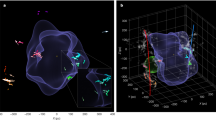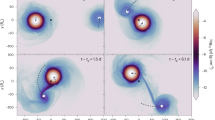Abstract
Our current understanding of the chemistry and mass-loss processes in Sun-like stars at the end of their evolution depends critically on the description of convection, pulsations and shocks in the extended stellar atmosphere1. Three-dimensional hydrodynamical stellar atmosphere models provide observational predictions2, but so far the resolution to constrain the complex temperature and velocity structures seen in the models has been lacking. Here we present submillimetre continuum and line observations that resolve the atmosphere of the asymptotic giant branch star W Hydrae. We show that hot gas with chromospheric characteristics exists around the star. Its filling factor is shown to be small. The existence of such gas requires shocks with a cooling time longer than commonly assumed. A shocked hot layer will be an important ingredient in current models of stellar convection, pulsation and chemistry at the late stages of stellar evolution.
This is a preview of subscription content, access via your institution
Access options
Access Nature and 54 other Nature Portfolio journals
Get Nature+, our best-value online-access subscription
$29.99 / 30 days
cancel any time
Subscribe to this journal
Receive 12 digital issues and online access to articles
$119.00 per year
only $9.92 per issue
Buy this article
- Purchase on Springer Link
- Instant access to full article PDF
Prices may be subject to local taxes which are calculated during checkout



Similar content being viewed by others
References
Habing, H. J. & Olofsson, H. Asymptotic Giant Branch Stars. (Springer, New York, Berlin, 2003).
Freytag, B., Liljegren, S. & Höfner, S. Global 3D radiation-hydrodynamics models of AGB stars. Effects of convection and radial pulsations on atmospheric structures. Astron. Astrophys. 600, A137 (2017).
Höfner, S. Winds of M-type AGB stars driven by micron-sized grains. Astron. Astrophys. 491, 1–4 (2008).
Woitke, P. 2D models for dust-driven AGB star winds. Astron. Astrophys. 452, 537–549 (2006).
Ireland, M. J., Scholz, M. & Wood, P. R. Dynamical opacity-sampling models of Mira variables—I. Modelling description and analysis of approximations. Mon. Not. R. Astron. Soc. 391, 1994–2002 (2008).
Bowen, G. H. Dynamical modeling of long-period variable star atmospheres. Astrophys. J. 329, 299–317 (1988).
Willacy, K. & Cherchneff, I. Silicon and sulphur chemistry in the inner wind of IRC + 10216. Astron. Astrophys. 330, 676–684 (1998).
Cherchneff, I. I. A chemical study of the inner winds of asymptotic giant branch stars. Astron. Astrophys. 456, 1001–1012 (2006).
Agúndez, M. & Cernicharo, J. Oxygen chemistry in the circumstellar envelope of the carbon-rich star IRC + 10216. Astrophys. J. 650, 374–393 (2006).
L. A. Willson, & G. H. Bowen, In Cyclical Variability in Stellar Winds 294–305 (eds Kaper, L. & Fullerton, A. W.) (Springer, 1998).
Johnson, H. R. & Luttermoser, D. G. Ultraviolet spectra and chromospheres of cool carbon stars. Astrophys. J. 314, 329–340 (1987).
Montez, R., Ramstedt, S., Kastner, J. H., Vlemmings, W. & Sanchez, E. A catalog of GALEX ultraviolet emission from asymptotic giant branch stars. Astrophys. J. 841, 33 (2017).
Tuthill, P. G., Haniff, C. A. & Baldwin, J. E. Surface imaging of long-period variable stars. Mon. Not. R. Astron. Soc. 306, 353–360 (1999).
Ragland, S. et al. First surface-resolved results with the Infrared Optical Telescope Array Imaging Interferometer: detection of asymmetries in asymptotic giant branch stars. Astrophys. J. 652, 650–660 (2006).
Ohnaka, K., Weigelt, G. & Hofmann, K.-H. Clumpy dust clouds and extended atmosphere of the AGB star W Hydrae revealed with VLT/SPHERE-ZIMPOL and VLTI/AMBER. Astron. Astrophys. 589, A91 (2016).
Khouri, T. et al. Study of the inner dust envelope and stellar photosphere of the AGB star R Doradus using SPHERE/ZIMPOL. Astron. Astrophys. 591, A70 (2016).
Tsuji, T., Ohnaka, K., Aoki, W. & Yamamura, I. Warm molecular envelope of M giants and Miras: a new molecule forming region unmasked by the ISO SWS. Astron. Astrophys. 320, L1–L4 (1997).
Khouri, T. et al. The wind of W Hydrae as seen by Herschel. II. The molecular envelope of W Hydrae. Astron. Astrophys. 570, A67 (2014).
Woodruff, H. C. et al. The Keck Aperture Masking Experiment: spectro-interferometry of three Mira variables from 1.1 to 3.8 μm. Astrophys. J. 691, 1328–1336 (2009).
Zhao-Geisler, R., Quireenbach, A., Köhler, R., Lopez, B. & Leinert, C. The mid-infrared diameter of W Hydrae. Astron. Astrophys. 530, A120 (2011).
Vlemmings, W. H. T., van Langevelde, H. J., Diamond, P. J., Habing, H. J. & Schilizzi, R. T. VLBI astrometry of circumstellar OH masers: proper motions and parallaxes of four AGB stars. Astron. Astrophys. 407, 213–224 (2003).
Reid, M. J. & Menten, K. M. Imaging the radio photospheres of Mira variables. Astrophys. J. 671, 2068–2073 (2007).
Reid, M. J. & Menten, K. M. Radio photospheres of long-period variable stars. Astrophys. J. 476, 327–346 (1997).
Lim, J., Carilli, C. L., White, S. M., Beasley, A. J. & Marson, R. G. Large convection cells as the source of Betelgeuse’s extended atmosphere. Nature 392, 575–577 (1998).
Harper, G. M., O’Riain, N. & Ayres, T. R. Chromospheric thermal continuum millimetre emission from non-dusty K and M red giants. Mon. Not. R. Astron. Soc. 428, 2064–2073 (2012).
Landau, L. D. & Lifshitz, E. M. Fluid Mechanics (Pergamon Press, Oxford, 1959).
Khouri, T. et al. ALMA observations of the vibrationally excited rotational CO transition v = 1, J = 3 - 2 towards five AGB stars. Mon. Not. R. Astron. Soc. 463, L74–L78 (2016).
Hinkle, K. H. Infrared spectroscopy of Mira variables. I. R Leonis: the CO and OH vibration-rotation overtone bands. Astrophys. J. 220, 210–228 (1978).
Danilovich, T. et al. Water isotopologues in the circumstellar envelopes of M-type AGB stars. Astron. Astrophys. 602, A14 (2017).
Lèbre, A. et al. Search for surface magnetic fields in Mira stars. First detection in χ Cygni. Astron. Astrophys. 561, A85 (2014).
Vlemmings, W. H. T., van Langevelde, H. J. & Diamond, P. J. The magnetic field around late-type stars revealed by the circumstellar H2O masers. Astron. Astrophys. 434, 1029–1038 (2005).
Martí-Vidal, I., Vlemmings, W. H. T., Muller, S. & Casey, S. UVMULTIFIT: a versatile tool for fitting astronomical radio interferometric data. Astron. Astrophys. 563, A136 (2014).
Magnum J.The Relationship Between Flux Density and Brightness Temperature (National Radio Astronomy Observatory, 2015); https://safe.nrao.edu/wiki/pub/Main/RadioTutorial/flux-to-brightness.pdf.
Condon, J. J. Errors in elliptical Gaussian fits. Publ. Astron. Soc. Pacific 109, 166–172 (1997).
Gendriesch, R. et al. Accurate laboratory rest frequencies of vibrationally excited CO up to v = 3 and up to 2 THz. Astron. Astrophys. 497, 927–930 (2009).
Höfner, S., Bladh, S., Aringer, B. & Ahuja R., Dynamic atmospheres and winds of cool luminous giants. I. Al2O3 and silicate dust in the close vicinity of M-type AGB stars. Astron. Astrophys. 594, A108 (2016).
Woitke, P., Helling, Ch, Winters, J. M. & Jeong, K. S. On the formation of warm molecular layers. Astron. Astrophys. 348, L17–L20 (1999).
Tsuji, T. High resolution spectroscopy of CO in the infrared spectra of cool stars—turbulent velocities and carbon abundance in M-giant stars. Astron. Astrophys. 156, 8–21 (1986).
Humphreys, E. M. L. et al. Simultaneous 183 GHz H2O Maser and SiO observations towards evolved stars using APEX SEPIA Band 5. Astron. Astrophys. 603, A77 (2017).
Remijan, A. J., Markwick-Kemper, A., ALMA Working Group on Spectral Line Frequencies. Splatalogue; Database for Astronomical Spectroscopy. Bull. Am. Astron. Soc. 39, 963 (2007).
Underwood, D. S. et al. ExoMol molecular line lists – XIV. The rotation–vibration spectrum of hot SO2. Mon. Not. R. Astron. Soc. 459, 3890–3899 (2016).
Acknowledgements
Support for this work was provided by the European Research Council (ERC) through the ERC consolidator grant number 614264, and by the Swedish Research Council (VR). E.D.B. further acknowledges support from the Swedish National Space Board. We are also indebted to the staff of the Nordic ALMA regional centre node, and in particular I. Martí-Vidal, for developments of the tools used in the data analysis and plotting. ALMA is a partnership of the European Southern Observatory (ESO, representing its member states), the National Science Foundation (United States) and the National Institutes of Natural Sciences (NINS, Japan), together with the National Research Council (Canada), the National Science Council (Taiwan), the NINS in collaboration with the Academia Sinica (Taiwan) and the Korea Astronomy and Space Science Institute (Republic of Korea), in cooperation with the Republic of Chile. The Joint ALMA Observatory is operated by ESO, Associated Universities Inc./National Radio Astronomy Observatory and the National Astronomical Observatory of Japan.
Author information
Authors and Affiliations
Contributions
W.V. reduced and analysed the data and wrote most of the manuscript. T.K. performed the radiative-transfer modelling and wrote the modelling section of the Methods. E.D.B. and B.L. analysed the unidentified line and provided the relevant text. A.T. obtained the ALMA data. All authors contributed with comments on the manuscript and data interpretation.
Corresponding author
Ethics declarations
Competing interests
The authors declare no competing financial interests.
Additional information
Publisher’s note: Springer Nature remains neutral with regard to jurisdictional claims in published maps and institutional affiliations.
Electronic supplementary material
Supplementary Information
Supplementary Figures 1–6 and Supplementary Table 1
Rights and permissions
About this article
Cite this article
Vlemmings, W., Khouri, T., O’Gorman, E. et al. The shock-heated atmosphere of an asymptotic giant branch star resolved by ALMA. Nat Astron 1, 848–853 (2017). https://doi.org/10.1038/s41550-017-0288-9
Received:
Accepted:
Published:
Issue Date:
DOI: https://doi.org/10.1038/s41550-017-0288-9



